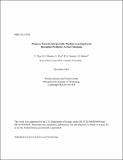Progress Towards Interpretable Machine Learning-based Disruption Predictors Across Tokamaks
Author(s)
Rea, Christina; Mones, K.J.; Pau, A.; Granetz, R.S.; Sauter, O.
Download19ja028_full.pdf (1.621Mb)
Metadata
Show full item recordAbstract
In this paper we lay the groundwork for a robust cross-device comparison of data-driven disruption prediction algorithms on DIII-D and JET tokamaks. In order to consistently carry on a comparative analysis, we define physics-based indicators of disruption precursors based on temperature, density, and radiation profiles that are currently missing for DIII-D data. These profile-based indicators are shown to well-describe impurity accumulation events in both DIII-D and JET discharges that eventually disrupt. Thanks to the univariate analysis on the features used in such data-driven applications on both tokamaks, we are able to statistically highlight differences in the dominant disruption precursors: JET with its ITER-like wall is more prone to impurity accumulation events, while DIII-D is more subject to edge cooling mechanisms that destabilize dangerous MHD modes. Even though the analyzed datasets are characterized by such intrinsic differences, we show how data-driven algorithms trained on one device can be used to predict and interpret disruptive scenarios on the other. As long as the destabilizing precursors are diagnosed in a device-independent way, the knowledge that data-driven algorithms learn on one device can be used to explain a disruptive behavior on another device.
Description
Submitted for publication in Fusion Science and Technology
Date issued
2019-12Department
Massachusetts Institute of Technology. Plasma Science and Fusion CenterJournal
Fusion Science and Technology
Publisher
Taylor & Francis
Other identifiers
19ja028